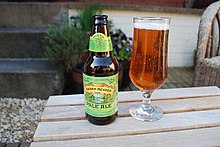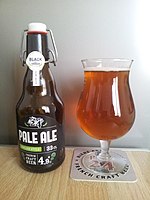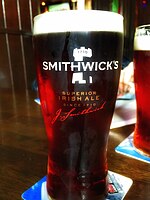Pale ale

Pale aleis a golden to amber colouredbeer stylebrewed withpale malt.[1][2][3]The term first appeared in England around 1703 for beers made frommaltsdried with high-carboncoke,which resulted in a lighter colour than other beers popular at that time. Different brewing practices andhopquantities have resulted in a range of tastes and strengths within the pale ale family.
History
[edit]Cokehad been first used for dry roasting malt in 1642, but it was not until around 1703 that the termpale alewas first applied to beers made from such malt. By 1784, advertisements appeared in theCalcutta Gazettefor "light and excellent" pale ale.[4]
By 1830, the expressionsbitterandpale alewere synonymous. Breweries tended to designate beers as "pale ales", though customers would commonly refer to the same beers as "bitters". It is thought that customers used the termbitterto differentiate these pale ales from other less noticeably hopped beers such asportersandmilds.
By the mid to late 20th century, while brewers were still labelling bottled beers as pale ales, they had begun identifying cask beers as "bitters", except those fromBurton on Trent,which tend to be referred to as "pale ales".[citation needed]
Types
[edit]Different brewing practices andhoplevels have resulted in a range of taste and strength within the pale ale family.[5]
Amber ale
[edit]
Collier Brothers of London applied for the UK trademark ofThe Amber Alein 1876 and the trademark was maintained through changes in ownership until it expired as UK00000009744 in 2002.[6]It was a "pure delicately hopped Pale Ale" positioned between their light bitter and IPA.[7]Since the expiry of the trademark some traditional British bitters have been rebranded as amber ales, in some cases to distinguish them from golden ales sold under the same brand egShepherd NeameSpitfire.
Amber aleis an emerging term used in Australia, France (asambrée), Belgium and the Netherlands and North America for pale ales brewed with a proportion ofamber maltand sometimescrystal maltto produce an amber colour generally ranging from light copper to light brown.[8]A small amount of crystal or other coloured malt is added to the basic pale ale base to produce a slightly darker colour, as in some Irish and British pale ales.[9]In France the term "ambrée"is used to signify a beer, either cold or warm fermented, which is amber in colour; the beer, as inPelforthambréeand Fischer amber, may be aVienna lager,or it may be abière de gardeas in Jenlainambrée.[10]In North America, American-varietyhopsare used in amber ales with varying degrees of bitterness, although very few examples are particularly hoppy.[11]Diacetylis barely perceived or is absent in an amber ale.[12]
American pale ale
[edit]
Anchor Liberty Ale, a 6% abv ale originally brewed by theAnchor Brewing Companyas a special in 1975 to commemoratePaul Revere's "Midnight Ride" in 1775, was seen byMichael Jackson,a writer on beverages, as the first modern American ale.[13]Fritz Maytag,the owner of Anchor, visited British breweries in London, Yorkshire andBurton upon Trent,picking up information about robust pale ales, which he applied when he made his American version, using just malt rather than the malt and sugar combination common in brewing at that time, and making prominent use of the American hop,Cascade.[13]By 1983, it was commonly found.[13][14]
The brewery thought to be the first to successfully use significant quantities of American hops in the notably hoppy style of an APA and use the specific name "pale ale" was theSierra Nevada Brewing Company.[15]It brewed the first experimental batch of Sierra Nevada Pale Ale in November 1980,[16]distributing the finished version in March 1981.[17]Other pioneers of a hoppy American pale ale areJack McAuliffeof theNew Albion Brewing Companyand Bert Grant ofYakima Brewing.[18][19]
American pale ales are generally around 5% abv, with significant quantities of American hops, typically Cascade.[20]Although American-brewed beers tend to use a cleaner yeast, and Americantwo rowmalt,[21][self-published source?]it the use of strong American hops in particular that distinguish an APA from a British or European pale ale.[22]The style is close to the AmericanIndia pale ale(IPA), and boundaries blur,[23]though IPAs are stronger and more assertively hopped.[24][self-published source?]The style is also close toamber ale,though these are darker and maltier due to the use of crystal malts.[25]
Australian pale ale
[edit]Australian pale aleis pale ale that is produced in Australia and developed in Australia around 1990s. Australian pale ales are generally around 6% abv with significant quantities of Australian hops, typicallyGalaxy.[26][27][28]
Bière de garde
[edit]
Bière de garde,or "keeping beer", is a pale ale traditionally brewed in theNord-Pas-de-Calaisregion of France. These beers were usually brewed by farmhouses in the winter and spring, to avoid unpredictable problems with the yeast during the summertime.
The origin of the name lies in the tradition that it was matured or cellared for a period of time once bottled (most were sealed with a cork), to be consumed later in the year, akin to asaison.
Among the better French known "bières de garde"areBrasserie de Saint-Sylvestre,Trois Monts, Brasseurs Duyck,Jenlainand Brasserie La Choulette,ambrée.
Blonde
[edit]Blonde ales are very pale in colour. The term "blonde" for pale beers is common in Europe and South America – particularly in France, Italy, Belgium, the Netherlands, the UK, and Brazil – though the beers may not have much in common, other than colour. Blondes tend to be clear, crisp, and dry, with low-to-medium bitterness and aroma from hops, and some sweetness from malt. Fruitiness fromestersmay be perceived. A lighter body from highercarbonationmay be noticed.
In the United Kingdom, golden or summer ales were developed in the late 20th century by breweries to compete with thepale lagermarket. A typical golden ale has an appearance and profile similar to that of a pale lager. Malt character is subdued and the hop profile ranges from spicy to citrus; common hops include Styrian Golding and Cascade. Alcohol is in the 4% to 5% abv range. The UK style is attributed to John Gilbert, owner ofHop Back Brewery,who developed "Summer Lightning" in 1989, which won several awards and inspired numerous imitators.[29]
Belgian blondesare often made withpilsner malt.[30]Some beer writers regard blonde and golden ales as distinct styles, while others do not.Duvelis a typical Belgian blonde ale, and one of the most popular bottled beers in the country[31]as well as being well known internationally.[32]
Burton pale ale
[edit]Late in the second half of the nineteenth century, the recipe for pale ale was put into use by theBurton upon Trentbrewers, notablyBass;ales from Burton were considered of a particularly high quality due to synergy between the malt and hops in use and local water chemistry, especially the presence ofgypsum.Burton retained absolute dominance in pale ale brewing[33]until a chemist, C. W. Vincent, discovered the process ofBurtonizationto reproduce the chemical composition of the water from Burton-upon-Trent, thus giving any brewery the capability to brew pale ale.
English bitter
[edit]
The expressionEnglish bitterfirst appeared in the early 19th century as part of the development and spread of pale ale.[34]Breweries tended to designate beers as "pale ales", though customers would commonly refer to the same beers as "bitters". It is thought that customers used the termbitterto differentiate these pale ales from other less noticeably hopped beers. Drinkers tend to loosely group modern bitters into "session" or "ordinary" bitters (up to 4.1% abv), "best" or "special" bitters (between 4.2% and 4.7% abv) and "strong" bitters (4.8% abv and over).[citation needed]
India pale ale (IPA)
[edit]India pale ale (IPA) is a style of pale ale developed in England for export to India. The first known use of the expression "India pale ale" is in an advertisement in theSydney Gazette and New South Wales Advertiseron 27 August 1829.[35]
Worthington White Shield,originating in Burton-upon-Trent, is a beer considered to be part of the development of India pale ale.
The colour of an IPA can vary from a light gold to a reddish amber.
Irish red ale
[edit]
The term "Irish red ale" was popularised in the United States and subsequently exported worldwide. The additional variants "red ale", "Irish ale" (Irish:leann dearg,[36]) and "Irish red", have come to be used by brewers mainly inIrelandand theUnited States,less so elsewhere.Smithwick'sandKilkennyare typical examples of macro-brewed commercial Irish red ale. There are many other smaller and craft examples, such as O'Hara's, Sullivan's, Murphy's, Porterhouse and Franciscan Well.
Irish red ales are characterised by their malt profile and typically have a sweet, caramel or toffee-like taste, low bitterness and amber to red colour - hence the name.[37]
Irish brewers have increasingly adopted the term Irish Red Ale to distinguish their beers in both the domestic and international markets. In the US, the name can also be used simply to describe a darker amber ale, or the abbreviated term "Irish Red" applied to a "reddish" beer brewed as alagerand ambered with caramel colouring - for exampleKillian's Irish Red.
Strong pale ale
[edit]Strong pale ales are ales made predominantly with pale malts and have an alcohol strength that may start around 5%, though typically at 7 or 8% by volume, and may go up to 12%, though some brewers have been pushing the alcohol strength higher to produce novelty beers. In 1994, theHair of the Dog Brewing Companyproduced a strong pale ale with an alcohol by volume of 29%. In 2010, Brewdog released "Sink the Bismarck!", a 41% abv pale ale,[38]which is stronger than typical U.S.distilled spirits(40% abv).
References
[edit]- ^"Roger Protz on India Pale ale".www.beer-pages.com. Archived fromthe originalon 8 June 2016.Retrieved3 October2010.
- ^Paige Williams (May 2003)."Atlanta, Vol. 43, No. 1".Atlanta.Emmis Communications: 104.ISSN0004-6701.Retrieved3 October2010.
- ^D. E. Briggs; J. S. Hough; R. Stevens; Tom W. Young (1982).Malting and Brewing Science.Springer. p. 810.ISBN978-0-8342-1684-6.Retrieved3 October2010.
- ^Steele, Mitch (10 September 2013).IPA: Brewing Techniques, Recipes and the Evolution of India Pale Ale.Brewers Publications.ISBN978-1-938469-02-2.
- ^India Pale AleArchived8 June 2016 at theWayback Machine,Roger Protz, beer-pages.com
- ^"Trade mark number UK00000009744".UK Intellectual Property Office.
- ^"Collier Brothers advert".Tottenham and Edmonton Weekly Herald.The British Newspaper Archive. 24 May 1879. p. 8.
- ^James Squire Amber AleArchived3 March 2016 at theWayback Machine-Michael Jackson1 October 2001: "The designation Amber Ale is to be taken seriously".
- ^"CraftBeer.com - American Ales".craftbeer.com.29 July 2012. Archived fromthe originalon 29 July 2012.
- ^"Duyck Jenlain Ambrée".ratebeer.com.2011.Retrieved11 August2011.
Jenlain Ambrée
- ^"Styles of Beer".themonk.com.au.28 September 2023.
- ^"Ale Styles Guide - IPA & Ale Beer Styles | Beer of the Month Club".The Microbrewed Beer of the Month Club.Retrieved24 June2018.
- ^abcMichael Jackson (1997).Michael Jackson's beer companion.Running Press. pp. 161–162.ISBN9780762402014.Retrieved8 July2011.
- ^Randy Mosher (2011).Tasting Beer.Storey. p. 212.ISBN9781603420891.Retrieved8 July2011.
- ^Sam Calagione (19 January 2011).Brewing Up a Business.John Wiley and Sons, 2011.ISBN9781118061879.Retrieved8 July2011.
- ^"Sierra Nevada Our Story".sierranevada.com.2009.Retrieved8 July2011.
- ^Maureen Ogle (2006).Ambitious Brew.Houghton Mifflin Harcourt. p.305.ISBN9780156033596.Retrieved8 July2011.
- ^John Holl (2011)."CraftBeer.com | Featured Brewery: New Albion Brewing".craftbeer.com.Archived fromthe originalon 24 June 2010.Retrieved8 July2011.
- ^Michael Jackson (2011)."Michael Jackson's Beer Hunter - How Bert Grant Saved The World".beerhunter.com.Retrieved8 July2011.
- ^"CraftBeer.com | American Ales".craftbeer.com.2011. Archived fromthe originalon 29 July 2012.Retrieved8 July2011.
- ^Chris Wright (2007).The Beer Journal.Lulu.com. p. 38.ISBN9781430312468.Retrieved8 July2011.[self-published source]
- ^Eric Asimov (28 June 2010)."Sampling American Pale Ales - NYTimes.com".The New York Times.New York.ISSN0362-4331.Retrieved8 July2011.
- ^Andy Crouch (2010).Great American Craft Beer.Running Press. p.126.ISBN9780762441600.Retrieved8 July2011.
- ^Chris Wright (2007).The Beer Journal.Lulu.com. p. 56.ISBN9781430312468.Retrieved8 July2011.[self-published source]
- ^Marty Nachel (2008).Homebrewing For Dummies.For Dummies. p. 128.ISBN9780470374160.Retrieved8 July2011.
- ^https://www.danmurphys.com.au/liquor-library/beer/styles/australian-pale-ale[bare URL]
- ^"Pale Ale Quick Guide | for Beginners".
- ^"Australian-Style Pale Ale (Ale) Beer Style Guidelines".
- ^"Hop Back Summer Lightning « Beer Culture with Des de Moor".desdemoor.co.uk.Retrieved5 June2010.
- ^Tim Webb.Good Beer Guide to Belgium,6th edition, p 81.
- ^The Complete Handbook of Beers and BrewingBrian Glover
- ^Miller, John W."Belgium's Duvel Finds Crafty Success".WSJ.
- ^Simmonds, Peter Lund (1858).The dictionary of trade products... - Google Books.Retrieved3 October2010.
- ^"Bitter, Ordinary and Special".All About Beer - Beer News, Reviews, Events, and Education.November 2004.Retrieved12 January2020.
- ^"Classified Advertising".The Sydney Gazette and New South Wales Advertiser (NSW: 1803 - 1842).NSW: National Library of Australia. 27 August 1829. p. 3.Retrieved17 August2013.
- ^"BeerTools.com Recipe Library - Leann Dearg".www.beertools.com.
- ^"Irish-style Red Beer".craftbeer.com.Retrieved1 October2021.
- ^"Hair of the Dog Dave from Hair of the Dog Brewing Company, a Barley Wine style beer: An unofficial page for Hair of the Dog Dave from Hair of the Dog Brewing Company in Portland, Oregon, United States of America".Ratebeer.com. 26 September 2013.Retrieved12 August2014.
Bibliography
[edit]- Farmhouse Ales: Culture and Craftsmanship in the European Tradition,Phil Markowski,ISBN0-937381-84-5
- Great Beer Guide: 500 Classic Brews,Michael Jackson,ISBN0-7513-0813-7
- Dictionary of Beer,Ed: A. Webb,ISBN1-85249-158-2
